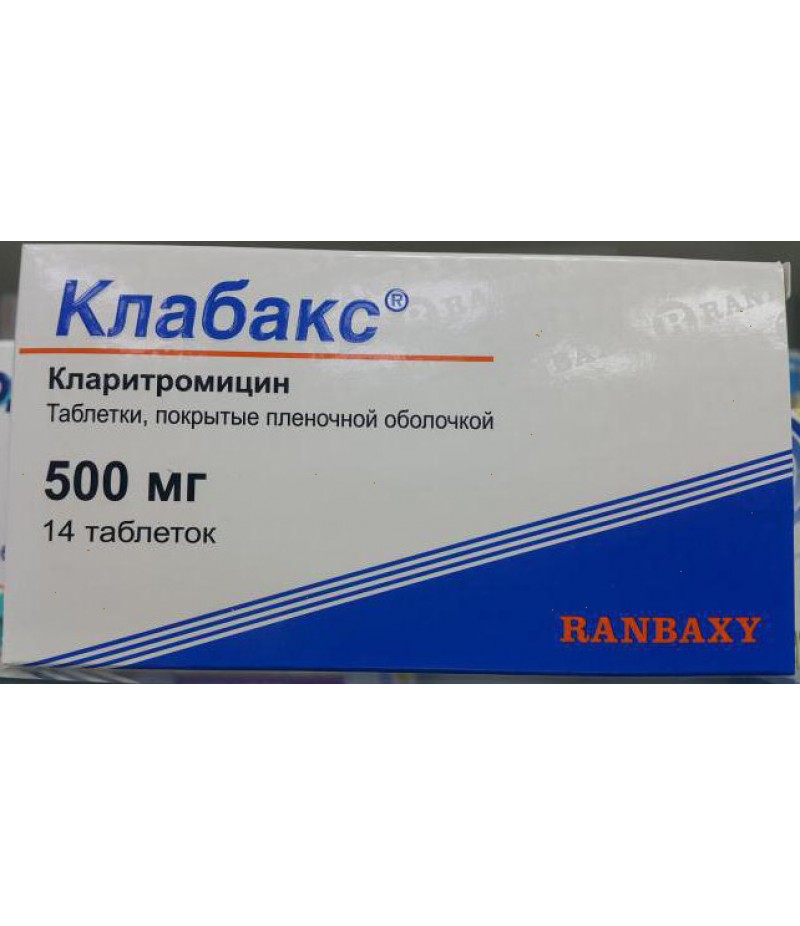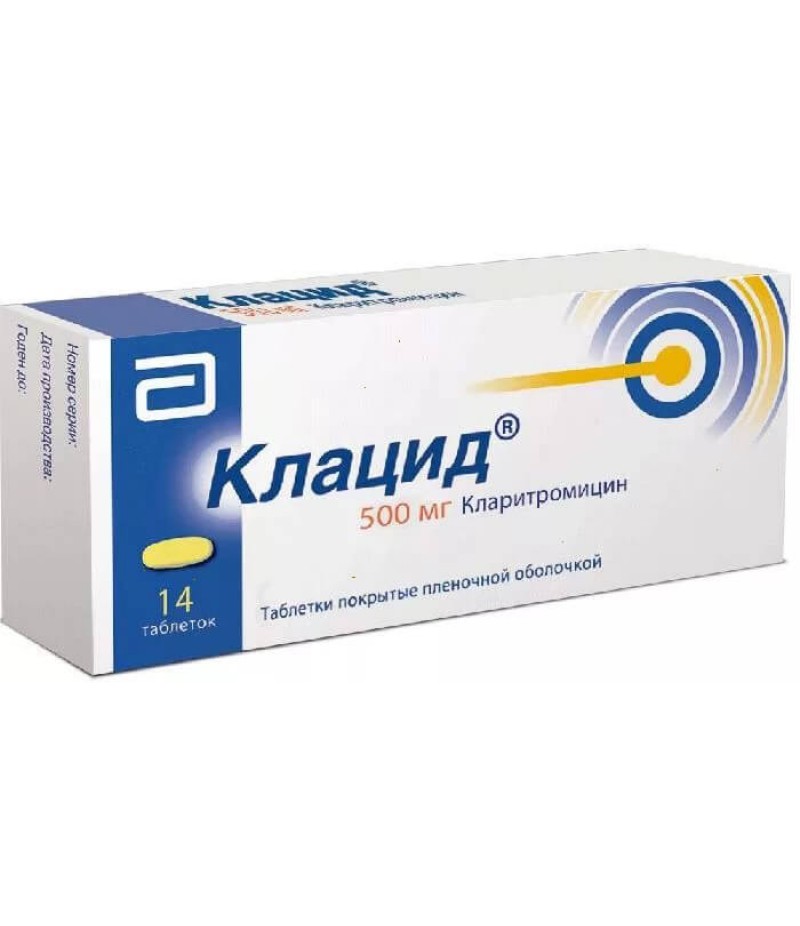Klabax tabs 500mg #14
- $26.99
- 3 or more $25.73
- Availability:In Stock
Klabax instructionYou can buy antibiotic Klabax on this pageCompositionAs part of a single Klabax tablets can contain 250 or 500 mg. clarithromycin (an active drug). As auxiliary compounds, the preparation includes substances such..
Tags: tabs
Klabax instruction
You can buy antibiotic Klabax on this page
Composition
As part of a single Klabax tablets can contain 250 or 500 mg. clarithromycin (an active drug). As auxiliary compounds, the preparation includes substances such as: povidone, silicon dioxide, MCC, AC-DI-Sol (croscarmellose sodium), purified talc, magnesium stearate and stearic acid.
The film coating of the drug contains: giprolose, titanium dioxide, hypromellose, sorbitan monooleate, yellow quinoline lacquer CI N 47005, purified water and talc, and also propylene glycol.
The composition of ink, with which to inscribe the tablet, includes substances such as: glazed shellac, propylene glycol, black iron oxide, N-butyl alcohol, purified water and isopropyl alcohol.
The composition of a single Klabax OD tablet prolonged action may include 500 mg. drug compound clarithrocin, as well as auxiliary substances such as hypromelose, povidone, magnesium stearate, silicon dioxide (colloidal), lactolose monohydrate, talc and sodium stearyl fumarate.
In the film coating of the Klabax OD tablets there is a yellow dye 20H52875 Opadry (titanium dioxide, yellow quinoline, talc, hypromellose, vanillin, giprolose and propylene glycol). The ink used for the inscription includes esterified shellac, Opacode-S-1-17734 ink, black iron oxide, propylene glycol, ammonium hydroxide, and methanol.
Form of issue
Klabax released in the form of tablets, covered with a special shell. One carton pack contains, as a rule, 1.3 10 blisters with 250 mg tablets. or 1 blister containing 10 tablets of 500 mg each.
Klabax OD is also produced in tablet form. However, as a rule, 1 or 2 blisters with 5-7 tablets (500 mg) are placed in one package of this medicine.
pharmachologic effect
Both drugs have bactericidal, antibacterial, as well as bacteriostatic action and belong to the group of antibiotics.
Pharmacodynamics and pharmacokinetics
These medicines refer to macrolides (ie antibiotics), which are distinguished by their wide spectrum of action. Klabax, as well as Klabax OD, are used in the treatment of a large number of various harmful microorganisms, for example, Streptococcus agalactiae, Haemophilus influenzae, Bordetella pertussis, Toxoplasma gondii, Eubacterium spp., Legionella pneumophila, Clostridium perfringens and so on, which provoke the development of bacterial infections of respiratory pathways, skin and intestinal tract.
Under the influence of an active substance contained in the chemical composition of preparations, the synthesis of the protein of harmful microorganisms is disrupted, both in in vitro (from the Latin language "in glass", ie when tested outside a living organism) and in vivo (in translation "on the living", ie tested on living organisms).
Due to its distinctive abilities, clarithromycin, which is part of both drugs, is metabolized in the liver by the cytochrome system. The bioavailability of these drugs is approximately 50%. Even with the regular intake of Klabax, the nature of metabolism, as well as the cumulation of the drug in the human body, does not change.
Clarithromycin binds to approximately 70% of the proteins that make up the blood plasma, which helps maintain the optimal level of drug substance in the body. Approximately 40% of the drug is excreted in the urine, and about 30% - through the intestine.
When administered orally, 14-hydroxyclarithromycin, as well as clarithromycin, penetrate quickly enough into the fluids and tissues of the human body. It is noteworthy that the concentration of active medicinal compounds in blood serum is several times less than in tissues.
Indications for use
So, from what Klabax helps or at treatment of what diseases this preparation is used:
infections of the upper respiratory tract caused by the negative impact of sensitive harmful microorganisms, for example, sinusitis, laryngitis, tonsillitis and pharyngitis;
infections caused by such harmful microorganisms as: Mycobacterium fortuitum, Mycobacterium intracellulare, Mycobacterium kansasii, Mycobacterium avium, and Mycobacterium chelonae;
stomach ulcer;
infections that affect soft tissues, and in addition, skin integuments, for example, furunculosis, wound infection, folliculitis and impetigo;
infections of the lower respiratory tract (pneumonia, bronchitis);
duodenal ulcer caused by eradication of Helicobacter pylori;
mycobacteriosis;
chlamydia.
Contraindications
Both drugs have the following contraindications:
porphyria;
age up to 12 years;
hypersensitivity to substances that are part of the drugs, as well as antibiotics;
the first trimester of pregnancy;
abnormal liver function;
use in the therapeutic treatment of ergot derivatives and some other drugs, such as Pomozidoma, Terfenadine, cisapride and Astemizole.
Side effects
Among the most common side effects of these drugs, the following ailments can be noted: abdominal pain, nausea, dizziness, diarrhea, variance, colitis, taste disorders, headaches, as well as increased hepatic enzyme activity, insomnia, depression, tinnitus, disorientation and confusion of consciousness.
During the use of medicines is extremely rare, but such side effects of drugs such as paresthesia, jaundice, nephritis, skin rash, Stevens-Johnson syndrome, urticaria, anaphylactic shock, leukopenia, hallucinations, arrhythmia or ventricular tachycardia can occur.
Klabax, instructions for use (Method and dosage)
Dosage, as, indeed, the schedule of taking medications depends on the prescription of the doctor, which is based on the severity of the disease, as well as the patient's state of health. The recommended average daily dose of Klabax for adult patients is 500 mg., It can be increased together in the presence of acute medical necessity. As a rule, the course of treatment with the drug is from 6 to 14 days.
Children who have reached the age of 12 are recommended to take 7.5 mg. medication 2 times a day for a maximum of 10 days.
If the patient has renal insufficiency, the dosage of the drug should be halved. During the treatment of diseases caused by the harmful effects of Mycobacterium avium, a daily dosage of 2 mg is recommended. clarithromycin, the duration of treatment in this case can be 6 months.
Instructions for the application of Klabax OD
Both adult patients and children from the age of 12 can take 500 mg orally. drug once a day for no more than 14 days. The schedule of taking the medicine, like its dosage, can be adjusted by the doctor depending on the severity of the infection and the patient's well-being. For patients with impaired renal function, the recommended dose should be reduced by 50%.
Overdose
In case of an overdose, symptoms such as diarrhea, nausea, headache, vomiting, confusion may appear. To eliminate the above listed ailments, you should wash the stomach, and stop taking the drug or reduce its dosage.
Interaction
In order to avoid an increase in the blood metabolism in the liver, both drugs should not be taken simultaneously with anticoagulants, as well as drugs such as Theophylline, Cisapride, Phenytoin, Carbamazepine, Triazol, Rifabutin, Midazol, Digoxin, and Cyclosporine and ergot alkaloids.
In addition, there is information on the development of necrosis of the skeletal muscles with simultaneous administration of drugs with Simvastatin and Lovastatin, which are inhibitors of hydroxymethylglutaryl-CoA reductase. With the combined use of clarithromycin in medicines and the clearance of triazolam, the likelihood of such side effects of the last drug as confusion and drowsiness increases severalfold.
Storage conditions
Both drugs are included in list B, so they should be stored in a place inaccessible to children, at a temperature not higher than 25 C.
Shelf life - 2 years.
special instructions
When using drugs in the treatment of patients with liver diseases that are chronic, it is required to carry out a constant monitoring of the level of enzymes in the blood. It is necessary to pay special attention to the dosage of medicines in the joint use of drugs that are actively metabolized by the liver.
When prescribing these medications, one should not forget about the so-called cross-resistance of some antibiotics related to macrolides. In addition, with prolonged treatment with Klabaxom, the patient may experience superinfection, i.e. a condition in which the patient's body against a disease is repeatedly infected with the same harmful bacteria and microorganisms.
Analogues of Klabax
The main analogues of Klabax can be considered:
Clarithromycin;
Klacid.
Children
Due to the presence of a rather large list of side effects, these medications are not recommended for use in the treatment of children under the age of 12 years.
During pregnancy (and lactation)
The use of drugs in the first trimester of pregnancy is strictly prohibited. In the future, drugs can be prescribed only in cases where there is an acute medical need for their use. This means that the use of these drugs can be justified by the intended use for the mother, which will greatly exceed the possible negative consequences for the development of the fetus.
During the use of these medications, doctors recommend stopping breastfeeding.
Reviews about Klabax
People who have tested the effectiveness of these antibiotics, for the most part, leave ambiguous comments on Klabax OD and Klabax. It's all about the side effects of drugs, which sometimes appear on the second day of taking the medicine.
Most often, patients complain of dizziness, nausea and vomiting, and bitterness in the mouth. Thus, often these drugs do not even have enough time to show their distinctive medicinal properties, as patients are forced to interrupt the therapeutic treatment.




